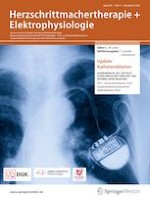Erschienen in:

06.11.2019 | Herzrhythmusstörungen | Schwerpunkt
Katheterablation von Herzrhythmusstörungen
Energieformen und biophysikalische Grundlagen
verfasst von:
Dr. Thomas Beiert, Prof. Dr. Jan W. Schrickel
Erschienen in:
Herzschrittmachertherapie + Elektrophysiologie
|
Ausgabe 4/2019
Einloggen, um Zugang zu erhalten
Zusammenfassung
Die kathetergeführte Ablation von Herzrhythmusstörungen hat sich über die Jahre zu einem Eckpfeiler der modernen Therapie von supraventrikulären und ventrikulären Arrhythmien entwickelt. Ziel der Ablation ist die permanente Schädigung eines Myokardareals, welches einen integralen Bestandteil des individuellen Arrhythmiemechanismus darstellt. Für die Arbeit im elektrophysiologischen Katheterlabor stehen unterschiedliche Katheter und Energieformen zur Verfügung. Am weitesten verbreitet ist die Radiofrequenz(RF)-Ablation, bei der durch Applikation eines Wechselstroms an der Katheterspitze Hitze erzeugt und so ein arrhythmogenes Substrat zerstört wird. Hohe Temperaturen (>70 °C an der Katheterspitze und >95 °C im Gewebe) bergen das Risiko für Koagelbildung sowie „steam pops“ und sollten vermieden werden, wodurch die Stromabgabe limitiert wird. Eine Weiterentwicklung stellt die gekühlte RF-Ablation dar. Diese ermöglicht die Applikation von mehr Leistung in das Gewebe und damit eine Zunahme der Läsionsausmesser. Als alternatives Verfahren hat sich die Kryoablation etabliert. Eine Kühlung des Gewebes auf bis zu −80 °C bewirkt die Bildung intra- und extrazellulärer Eiskristalle und dadurch letztlich die Ausbildung einer klar umschriebenen Narbe. Das sog. Kryo-Mapping mit höheren Temperaturen ohne direkte Gewebszerstörung erlaubt eine bessere Überprüfung der Sicherheit einer Ablation. Kryoenergie findet insbesondere bei der Pulmonalvenenisolation (PVI) breite Anwendung, durch Applikation mittels eines ballonbasierten Systems. Neben der PVI mit Hilfe eines Laserballons komplettieren als weitere, teils experimentelle Verfahren Ultraschall, Mikrowellenstrahlung und die stereotaktische Bestrahlung das Arsenal.